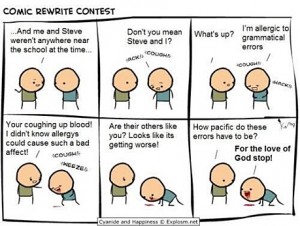The Dreaded Comma Splice!
by admin | 0 Comments
Ah, the comma splice… This grammar blunder struck fear in the deepest recesses of my heart in my high school English days and continues to make me shudder just a bit when I see one to this day. I can attribute this somewhat irrational fear of comma splices to my sophomore AP English teacher, Shirley Lyster. Miss Lyster threatened to give a failing grade to any paper that included even just one comma splice, hence my fear and trepidation. It worked, Miss Lyster! I now hate comma splices and spot them everywhere!
So, what is a comma splice? It is the use of a comma to “splice” two independent clauses together without a coordinating conjunction. Let’s look at the following example borrowed from the song “The Devil Went Down to Georgia” by The Charlie Daniels Band released on their 1979 album Million Mile Reflections: “The devil went down to Georgia, he was looking for a soul to steal.” This is a comma splice. We have two independent clauses (i.e., two sentences that can stand alone) that were erroneously joined together by a comma and nothing else.
We can fix this a number of ways. We can simply change the comma to a semicolon: “The devil went down to Georgia; he was looking for a soul to steal.” We can add a subordinating conjunction: “The devil went down to Georgia because he was looking for a soul to steal.” We can add a coordinating conjunction and a comma: “The devil went down to Georgia, and he was looking for a soul to steal.” We can add a conjunctive adverb and a semicolon: “The devil went down to Georgia; moreover, he was looking for a soul to steal.” Lastly, we can simply separate the two sentences into the two separate independent clauses by changing the comma to a period: “The devil went down to Georgia. He was looking for a soul to steal.”
While comma splices may not be the bane of modern life, they are a grammatical mistake that you should avoid. Thankfully, you have many tools at your disposal to fix these errors, so they are relatively easy to avoid.
Posted under : Punctuation Rules,Uncategorized,Writing Tips
